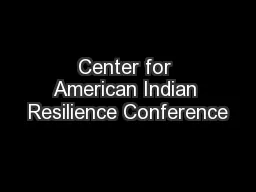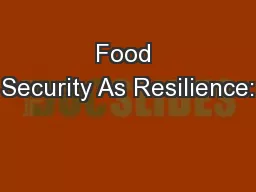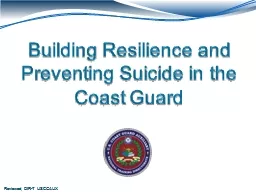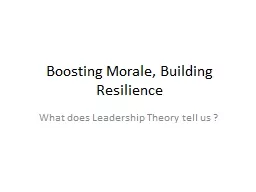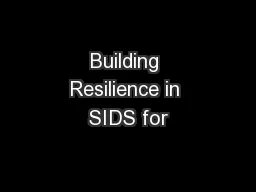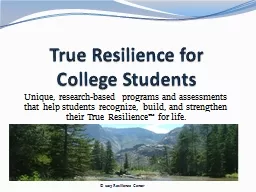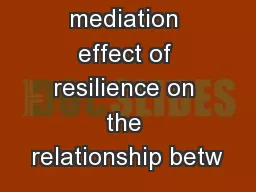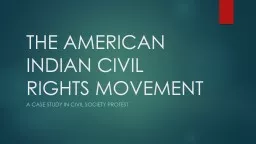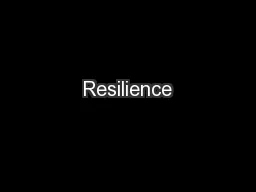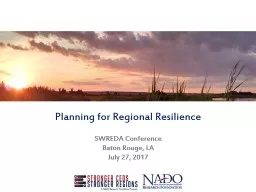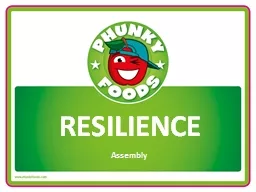PPT-Center for American Indian Resilience Conference
Author : stefany-barnette | Published Date : 2016-09-02
Plenary A What Does Academia Tell Us About American Indian Resilience Manley A Begay Jr Desert Diamond Conference Center Tucson Arizona August 7 8 2013 What
Presentation Embed Code
Download Presentation
Download Presentation The PPT/PDF document "Center for American Indian Resilience Co..." is the property of its rightful owner. Permission is granted to download and print the materials on this website for personal, non-commercial use only, and to display it on your personal computer provided you do not modify the materials and that you retain all copyright notices contained in the materials. By downloading content from our website, you accept the terms of this agreement.
Center for American Indian Resilience Conference: Transcript
Plenary A What Does Academia Tell Us About American Indian Resilience Manley A Begay Jr Desert Diamond Conference Center Tucson Arizona August 7 8 2013 What is Resiliency Most . Surviving and keeping life in balance . CAIR Conference. Tucson, AZ 8/7/2013. More attention given to acknowledging Native Peoples’ resiliency. Defining resilience. R. esilience. . “[We are like a] blade of grass. When stepped on, it bounces back and suggests that there’s a strong inner core there that allows families to carry on [with the] stresses of life that come to everyone.”. Reconciling Definition And Measurement. Joanna B. Upton, Jennifer . Denno. . Cissé. & Christopher . B. Barrett. Charles H. Dyson School of Applied Economics & Management. Cornell University. . Introduction. At the U.S. Coast Guard, we have the important mission of protecting our nation. To accomplish this mission, we work hard – around the clock, around the world. It’s important in this environment to stay healthy, to cope with the challenges we encounter, and to have support and resources available when we need them. The goal is to be . What does Leadership Theory tell us ?. Why Does Morale Need Boosting ? . It is the . complexities and subtleties . of the emotions that many teachers experience and manage in every school . day. . T. Trade & Climate Change Policies. Robert Read . Lancaster University Management School, UK. Key Elements of the . Size-Growth Relationship. Key economic characteristics of small size:. Small populations. College Students. Unique, research-based programs and assessments that help students recognize, build, and strengthen . their True Resilience™ for life.. © 2015 Resilience Center. True Resilience . Shaobing. Su. 1. , Xiaoming Li. 1. , Liying Zhang. 1. , Shan Qiao. 1. , . Juxian. Pan. 2. , . Weigui. Guo. 2. , . Yuejiao. Zhou. 3. ,. . Peiying. . Zuo. 4. 1 Department of Pediatrics Prevention Research Center, School of Medicine, Wayne State University, Detroit, MI 48201, USA.. A Case Study in Civil Society Protest. CHANGING AMERICAN INDIAN POLICY. Open warfare, followed by treaty-making, beginning in 1778. Forced removal of Eastern Indians to west of the Mississippi River, the Indian Removal Act of 1830 (the “Trail of Tears”, beginning in 1831). Defined. Day 2. Most . RESILIENT. creatures on Earth. Humans. Over millions of years, humans have transformed and evolved from living in the forests to being at the top of the food chain. Humans as a whole species adapt and transform any environment to meet the needs of that community, for good and bad.. Eric Meredith. OPI Data Analyst. 7/13/2017. Montana American Indian Student Achievement Data Report . 20,532 American Indian/Alaska Native students in Montana for 2016-2017. 14.0% of K-12 student population. Sue Stephenson, MD. Sonoma County ACEs Connection. May 30, 2017. GOALS. Understand science and concepts behind ACEs and resilience. Relate neuroscience to trauma-informed care. Develop language to receive and discuss new information and apply new studies. SWREDA Conference. Baton Rouge, LA . July 27, 2017. . . . Today’s Presentations . Kim Marousek. ,. . Director of Planning, Capital Region Planning Commission, Baton Rouge, LA . Bouncing back - the ability to . recover quickly from . difficulties.. Being . positive, even when things don’t seem to be going well. …. Believing . in . yourself and your goals.. Not being afraid to make mistakes.. Experience the best eye care center in Pune. The best clinics for your eye health, include the prestigious Dr. Sonalika Eye Clinic. At Hadapsar, Amanora, Magarpatta, Mundhwa, Kharadi Rd, Viman Nagar, Wagholi, and Wadgaon Sheri
Download Document
Here is the link to download the presentation.
"Center for American Indian Resilience Conference"The content belongs to its owner. You may download and print it for personal use, without modification, and keep all copyright notices. By downloading, you agree to these terms.
Related Documents

